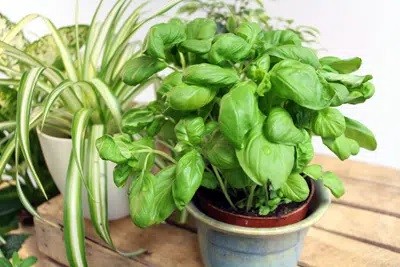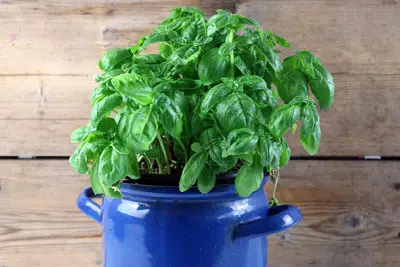It is rather normal than unusual in our latitudes that basil develops black spots on the leaves. In the article you will learn how to prolong the life of basil pot in the kitchen and that only home-grown basil of the right varieties provides a real guarantee against black spots.
Contents
The possible causes
Don’t worry, you’re not supposed to become a plant scientist for the sake of your basil – but a few ideas about the causes can help a lot when dealing with the problem. Some choices there are, then birch is a sensitive, heat-loving Mediterranean plant that dislikes all sorts of things:
- From temperatures below 12 °C there is pretty sure damage, e.g. the typical spots on the leaves
- Such low temperatures can happen to a basil outdoors
- However, cold spots can also occur in hot midsummer
- Wrong watering can be to blame
- The tender herb does not want to be watered from above, nor to be sprayed
- It could also be sunburn from too much direct sunlight
- Or a combination of both, water droplets can focus sunlight
- When wind is added to the mix, the basil has a definitive “snuffy” reaction
- All these conditions weaken, weakened plants are gladly colonized by fungi
- Fungi and other weakening diseases can cause dark spots on the leaves
The pots are mass produced in large-scale nurseries: Seeds suitable for turbo rearing grow under optimized lighting in optimum temperatures to the height and leaf mass desired at the time of sale. This basil is not produced to take a place in the herb garden over the summer. It is “ware in pot storage” intended to survive until the average customer has eaten the last little leaf; a disposable product that stays fresh through roots and near-earth substrate without flavor-destroying refrigeration.
How to prevent black spots
- Leave foil on the pot to increase the humidity of the air
- Place basil in a bright, warm room
- Better in partial shade than in full sun
- Basil on the balcony only grows well in sheltered, sunny locations without midday sun
- And only when it is warm day and night
- Always water only directly on the soil in the root area
- Move basil away from houseplants that may be spreading fungus.
- The foil can be cut away cm by cm from the top
- In this way the young plant can get used to the environment, but gets more air against fungi.
- Cut away leaf spots as soon as they develop or cut off infested leaves.
- Water moderately but regularly and continue harvesting, perhaps a few healthy leaves will grow up.
Produces long greens, but many basil pots have already picked up their damage in transit or at the supermarket (store). If leaf spots develop, you can limit the damage by selective harvesting: Leaves with dark spots can be eaten without problems, just don’t look as decorative anymore. They therefore go into stews or pesto, while the green leaves may decorate mozzarella and tomatoes.
Help basil live longer without leaf spots

If you want a pot of basil from the supermarket to accompany you longer, there is a little more to do. Because the reasons just explained for basil to die at home, not only in your home, of course also ensure that the basil does not continue to grow (it is not supposed to; it should survive in its purchased form, but certainly not “mutate into an eternally self-renewing product”).
You have just purchased a very young seedling that has been forced into rapid, slender to lanky growth and has not yet had time to strengthen itself. On the contrary, rather, the little plant was well shaken during transport, stood around somewhere in the cold or heat, saw little light and even less (or at one time excessive) water. So, first of all, some rest and strengthening is called for, before they help the plant youngster to better growing conditions:
- Immediately after purchase cut foil at the bottom and check potting substrate
- Drain substrate that is too wet
- Dust-dry substrate (more often) subject to an immersion bath and allow to drain
- Let basil with foil rest for a day or two in a light, warm spot
- Then free from the nutrient-poor commercial substrate
- Loosen root area all around by pressing and pot out basil
- Depending on the amount of fine roots, place in one or more new pots
- Each root ball should take up only about one third of the pot in the middle.
- Fill pots with loose garden soil or good, peat-free growing medium
- If using store-bought soil, choose quality potting soil (and not low-nutrient herb soil)
- Regularly provide a medium amount of moisture, basil does not like waterlogging or dryness.
- Always water from below, never on the leaves
- In early summer, summer gladly on the balcony
- Preferably in a sheltered corner with morning sun (and sun in the afternoon)
- The Mediterranean plant loves full sun, but only after acclimatization.
- So gradually expose a little more to the sun
In case of high heat, cover with foil again, water more often (gladly in the planter, drain after 15 min).
As a strong grower basil needs a lot of nutrients, in the pot it is best to use mineral-organic liquid fertilizer.
If you give your basil this slightly elaborate treatment, you have a good chance of never seeing spots on the leaves. What should not tempt you, however, is to pick off the largest leaves all around when harvesting, this will take away the tender plant’s desire for night shoots. Better to pinch off / cut off a whole piece of shoot above a leaf axil at a time, then new shoots will grow from the leaf axil, the plant will become bushier.
However, there is one caveat that cannot be explained away: Basil pots are produced and sold as food, which, if properly treated, achieves an amazingly long shelf life with full flavor. But this is the shelf life of a fresh herb, which is measured in days even without “contamination by fungi or microbes” or whatever other conspiracy theory is circulating on the Internet at the moment.
Resistant green plants that can be kept for weeks to years, grown under hardening conditions and sold in nutrient-rich substrate, are available from the gardener and not in the supermarket – which is why we are coming to them now:
Conclusion
The basil with unsightly spotted foliage is not abnormal, but rather the rule. How you deal with the problem and what the chances are that your measures will work, depends crucially on the type and origin of basil. Only the home-grown basil, if well cared for, will never develop black spots on the leaves.


